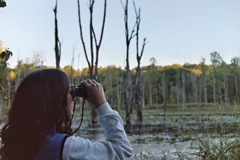Sonya Steckler
steckler@email.arizona.edu
Background:
I am a master’s student in the Conway Lab. Born and raised in Cleveland, Ohio, I graduated from Northwestern University in 2000 with a B.A. in French and Art History. I spent the following year volunteering in Israel, where I worked on a variety of projects, including teaching and tutoring English, improving trails in a national forest, and assisting with mist-netting and data collection for a migratory bird project. This last experience motivated me to pursue a career in ecology, so I went back to school a year later and earned a B.S. in Biology from Cleveland State University in 2005. There, I worked with Dr. B. Michael Walton on studying effects of the Red-backed salamander, Plethodon cinereus, on invertebrate community composition in a forest-floor food web. In the summer of 2004 I took field courses (including field ornithology) at the Rocky Mountain Biological Laboratory in Gothic, Colorado. It didn’t take long to realize that I wanted to study avian ecology in graduate school. During my senior year at Cleveland State University I worked with Dr. Dan Petit on an honors thesis investigating waterfowl and wading bird abundance and diversity in small wetlands during fall migration. As a recent Midwestern transplant, I have enjoyed studying the ecology of desert riparian songbirds in southeastern Arizona.
Research:
My master’s thesis research examines relationships between host behavior (primarily song rate) and Brown-headed Cowbird (Molothrus ater) parasitism in Arizona Bell’s Vireos (Vireo bellii arizonae). We generally see a positive correlation between host behavior and brood parasitism in cowbird hosts, but recent work by Sharp and Kus in southern California has shown the opposite pattern for Least Bell’s Vireos (V. b. pusillus). I am testing 5 hypotheses to explain why Bell’s Vireos show a negative correlation between song rate and parasitism. These hypotheses look at relationships between vocal behavior and nest concealment, clutch mass, nest predation, nest attentiveness by vireos, and cowbird densities. To test predictions of my hypotheses, I am collecting data on song rate, nest attentiveness, and nest concealment for 3 populations of vireos breeding in riparian woodlands in southeastern Arizona. Understanding why unparasitized vireos sing more frequently than parasitized ones may shed light on potential interactions between nest-site features and host behavior, as well as potential adaptive functions of frequent vocalizing near the nest. Understanding relationships between host behavior and parasitism is especially critical for Bell’s Vireo, which has experienced declines throughout its range, and is a species of conservation concern in Arizona. Besides distinguishing among competing hypotheses, my research will provide further data on parasitism frequency and its effects on vireo nest success.



- Sharp, C. C., S. E. Steckler, O. M. Lockhart, and B. M. Walton. 2005. Plethodon cinereus (Eastern red-backed salamander). Predation. Herpetological Review 36: 296-297.
- Walton, B. M., and S. Steckler. 2005. Contrasting effects of salamanders on forest-floor macro- and mesofauna in laboratory microcosms. Pedobiologia 49:51-60.